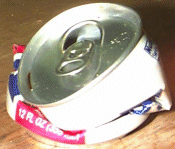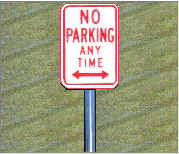|
The History and Meaning of Zorkballby Sean Carman |
|
|---|
Zorkball is a game we invented in junior high, played in high school to stave off boredom during lunch hour, and then quickly forgot. Recently the Disney Corporation contacted Manus to express interest in promoting Zorkball on one of the Disney cable channels (see related link). We thought, Could Zorkball have some intrinsic appeal that we missed? Something that could be exploited by skillful marketing? Or has the airless expanse of digital cable formed such a vacuum in television programming that ordinary street games have become suitable broadcast material? In order to answer these nagging questions, we present this essay on the History and Meaning of Zorkball.
Zorkball is played with an aluminum soda can crushed into the shape of a disk, like a light aluminum hockey puck. Two two-player teams battle to score points by throwing or kicking the zork (the crushed can) against a metal No Parking sign. A garden hose in a three-meter circle around the sign marks an area inside which one may not touch the zork with his or her hands. This area is the "HEZ," which stands for either the "Hose-Enclosed Zone" or the "Hand Exclusion Zone," we can't recall which. Whatever the name signifies, the HEZ makes scoring sufficiently difficult to lend minimal interest to the game. The field should consist of dirt or grass, and include a sloped concrete curb approximately 20 feet from the No Parking sign. Each game begins with one team taking possession of the zork away from the signpost. No player may take more than one step while holding the zork. During play the defending team can do almost anything to prevent the zork from touching the signpost. If a player sends the zork out of bounds the opposing team is granted a free kick from the curb, called a "chip zork." Play runs for 20 minutes with no stoppage, not even for medical emergencies.
The name Zorkball originated with our grade school English teacher, who prepared us for high school by giving us deflated letter grades and punishing us for misspelling eccentric phrases -- phrases you would drop into cocktail party conversations to impress people you didn't like. We responded by making her class the namesake of a sport played with a crushed can. From such humble, some might say petty, origins did Zorkball emerge. On the other hand, we may have named it after our friend and occasional participant Jim Zook. We can't recall. It was a long time ago.
The greatest aspect of Zorkball is a successful chip zork, that is, a score on a free kick from the curb. A crushed aluminum can possesses some loft, and from the sloped curb a player can lift it in a perfect arc and strike the No Parking sign with a satisfying metallic ring. Imagine the chime of a cash register accompanying every dunk in the NBA and you have the idea.
On most points, however, the zork travels only a few feet before lodging hopelessly in the dirt or grass. The frustration of trying to dislodge a flattened aluminum can from the ground, especially inside the HEZ where you can only use your feet and must confront a hostile opponent, represents a critical element of the game. A favored defensive strategy pioneered early in the game's history involves blocking the sign while holding it with one hand. During play the No Parking sign should look like the center of a rugby scrum. A good game of Zorkball will be completely inscrutable to the casual observer.
Most of the action in Zorkball occurs in close quarters and is visible only to the contestants. If it ever becomes a popular professional sport it is likely to be played in front of confused, milling stadium crowds. One can only hope that off-track betting will be available to keep their boredom from inciting riots. As for the view from the stands, we picture a scene out of a Monty Python skit: Four players clustered around a metal pole, in the center of a crowded stadium, a referee nervously fidgeting about with a red flag on a stick, tentatively raising it once or twice, never sure whether to call a foul or let play continue.
There you have it: Zorkball in a nutshell. Introduce it to your children. Ensure its legacy. Watch for it on your local cable network.

